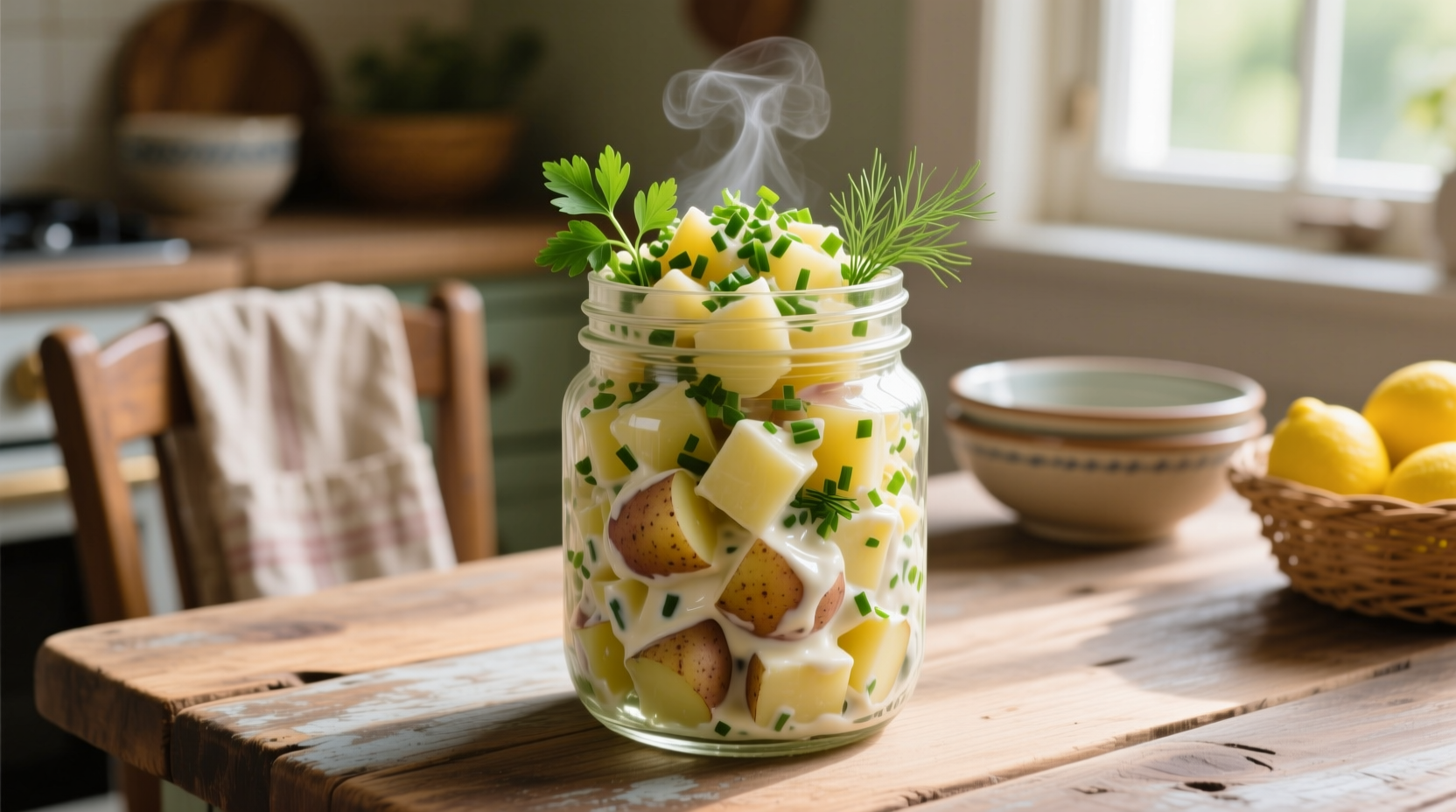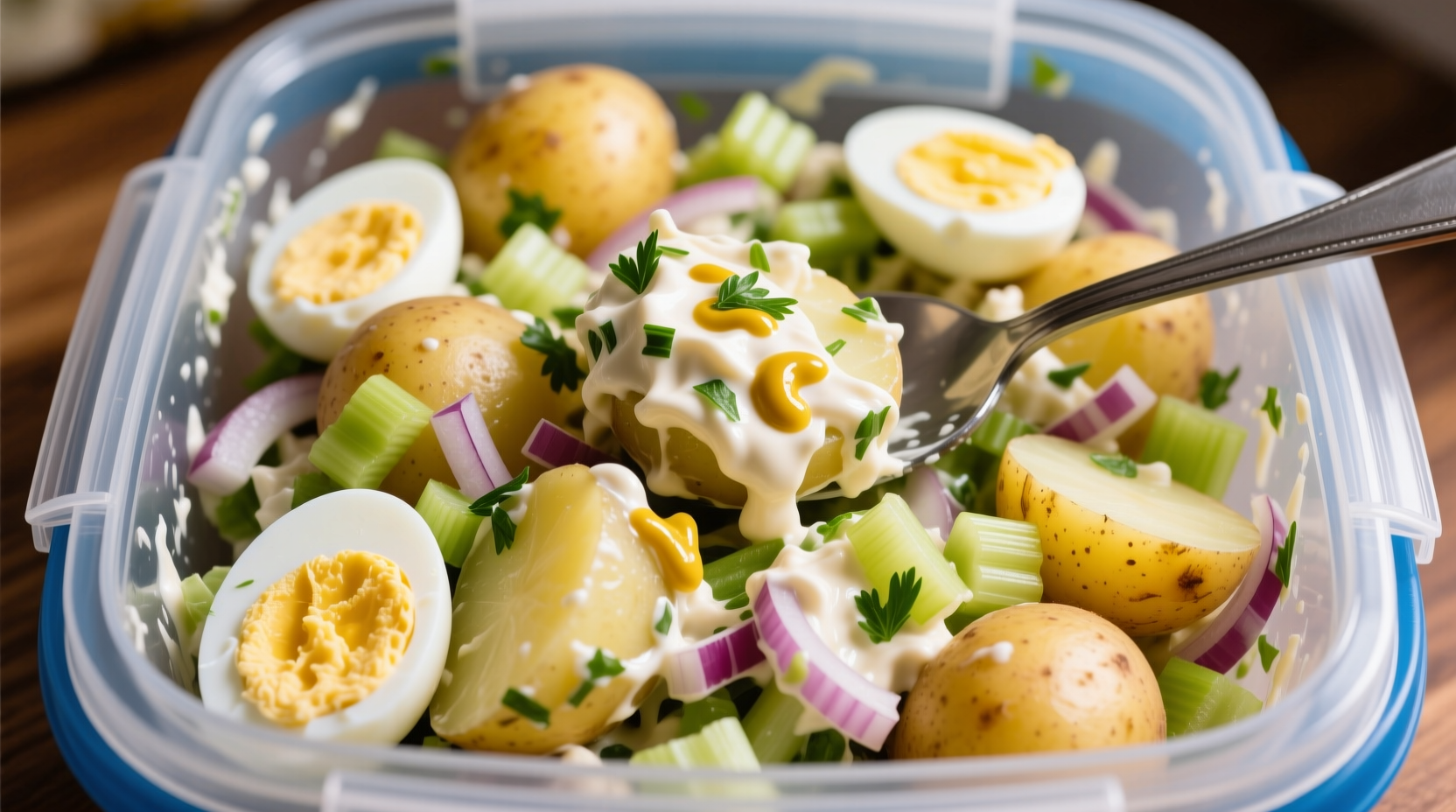Nothing beats the creamy, tangy goodness of homemade potato salad at summer gatherings. But when that last scoop sits in your fridge, you're probably wondering: Is this still safe to eat? As someone who's worked in professional kitchens for over 15 years, I've seen too many foodborne illness cases stem from improper storage of seemingly harmless dishes like potato salad. Let's get you the facts you need to enjoy your favorite side dish safely.
Understanding Potato Salad Shelf Life
Potato salad occupies a unique space in food safety because it contains multiple ingredients with different spoilage timelines. The critical factor determining how long homemade potato salad remains safe isn't just the potatoes themselves, but the mayonnaise or dressing base and storage conditions.
According to the USDA Food Safety and Inspection Service, cooked egg and potato dishes containing mayonnaise should be consumed within 3-5 days when stored properly in the refrigerator. Commercially prepared mayonnaise contains acids that actually help preserve the salad, but homemade versions with raw eggs present greater risk.
Factors That Determine Your Potato Salad's Freshness
Not all potato salads are created equal when it comes to shelf life. Consider these critical variables:
- Mayonnaise type - Commercial mayo (acidified) vs. homemade (raw eggs)
- Egg preparation - Hard-boiled eggs last longer than those prepared with runny yolks
- Added ingredients - Bacon, celery, onions affect moisture content
- Dressing acidity - Vinegar-based dressings extend shelf life slightly
- Initial preparation temperature - How quickly it was cooled after making
| Storage Condition | Maximum Safe Time | Risk Level |
|---|---|---|
| Refrigerator (40°F or below) | 3-5 days | Low (when properly stored) |
| Cooler with ice (below 40°F) | 2 hours | Moderate |
| Room temperature (70°F) | 2 hours | High |
| Warm environment (above 90°F) | 1 hour | Very High |
Proper Storage Techniques That Extend Freshness
How you store your potato salad makes all the difference in maximizing its safe consumption window. Follow these professional kitchen practices:
- Cool rapidly - Spread warm potato salad in a shallow container to cool faster before refrigerating
- Air-tight containers - Use containers with tight-fitting lids to prevent moisture loss and odor absorption
- Refrigerate immediately - Don't let it sit out while the rest of dinner finishes
- Store on middle shelf - Avoid the refrigerator door where temperatures fluctuate
- Keep separate - Don't mix fresh and older portions together

When to Definitely Throw Out Your Potato Salad
Trust your senses when evaluating potato salad safety. Discard immediately if you notice any of these warning signs:
- Visible mold - Any fuzzy spots or discoloration
- Unpleasant odor - Sour, rancid, or otherwise "off" smells
- Texture changes - Excessive liquid separation or slimy consistency
- Strange taste - Never taste questionable food to "check" if it's safe
The Centers for Disease Control and Prevention reports that potato salad is frequently implicated in summer foodborne illness outbreaks, particularly when left out too long at picnics and barbecues. When in doubt, throw it out—no side dish is worth risking food poisoning.
Special Considerations for Different Potato Salad Variations
Not all potato salads follow the same safety rules. Consider these variations:
- German-style potato salad (vinegar-based, warm serving) - Slightly longer shelf life due to higher acidity
- Mayo-free versions (mustard or olive oil based) - May last up to 5 days with proper storage
- Salads with bacon or meat - Shorter shelf life (3 days maximum) due to additional protein sources
- Eggless versions - Slightly extended safety window but still follow 5-day rule
Food Safety Timeline: From Preparation to Discard
Understanding the progression of bacterial growth in potato salad helps explain why timing matters:
- 0-2 hours at room temperature - Bacteria begin multiplying slowly
- 2-4 hours - Bacterial growth accelerates exponentially
- 4-6 hours - Dangerous levels of pathogens like Staphylococcus aureus may develop
- 24 hours - Visible spoilage signs typically appear
- 3-5 days refrigerated - Maximum safe consumption window
This timeline explains why the "2-hour rule" exists for perishable foods. The FDA Food Code specifically identifies potato salad as a potentially hazardous food due to its combination of protein-rich ingredients and neutral pH.
Practical Tips for Maximizing Enjoyment and Safety
As a professional who's handled thousands of potato salads, here are my top recommendations:
- Label containers with preparation date using masking tape
- Divide large batches into smaller portions to minimize temperature exposure
- Keep a dedicated refrigerator thermometer to verify proper temperature
- When serving outdoors, nest the bowl in ice to maintain safe temperatures
- Consider making smaller batches more frequently rather than one large batch
Remember that food safety guidelines exist because foodborne illnesses aren't just unpleasant—they can be dangerous, especially for vulnerable populations. The National Center for Home Food Management at the University of Illinois emphasizes that proper refrigeration is the single most effective way to prevent foodborne illness from dishes like potato salad.
Frequently Asked Questions
Can I freeze homemade potato salad to extend its shelf life?
Freezing potato salad is not recommended as the potatoes become waterlogged and the mayonnaise separates upon thawing. The texture becomes unappetizing and the safety risks increase due to improper freezing/thawing practices. It's better to consume within 5 days or make a fresh batch.
Does adding vinegar or mustard extend potato salad's shelf life?
Yes, acidic ingredients like vinegar or mustard can slightly extend shelf life by creating a less hospitable environment for bacteria. However, this only adds about 12-24 hours to the standard 3-5 day window. Never rely solely on acidity for food safety—proper refrigeration remains essential.
What's the difference between "use by" and "best by" dates for potato salad?
"Use by" dates indicate when food should be consumed for safety reasons, while "best by" refers to quality. For homemade potato salad, treat the 3-5 day guideline as a "use by" date. Commercially prepared potato salad may have "best by" dates that indicate peak quality, but safety still depends on proper storage after opening.
Can I tell if potato salad is safe by tasting a small amount?
No, never taste food to determine if it's safe. Harmful bacteria that cause foodborne illness don't always change the taste, smell, or appearance of food. If potato salad has been stored longer than 5 days or left at room temperature too long, discard it without tasting.
Why does potato salad go bad faster than plain boiled potatoes?
Potato salad spoils faster than plain boiled potatoes because it combines multiple perishable ingredients. The mayonnaise (especially if homemade with raw eggs), cooked eggs, and other additions create an ideal environment for bacterial growth. Plain boiled potatoes in their skins can last 5-7 days refrigerated, but the combination in potato salad reduces this window significantly.











 浙公网安备
33010002000092号
浙公网安备
33010002000092号 浙B2-20120091-4
浙B2-20120091-4